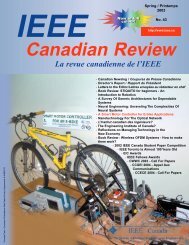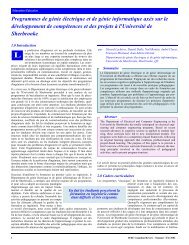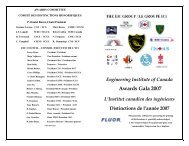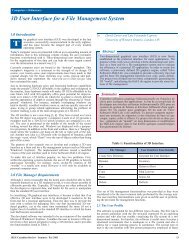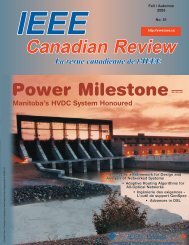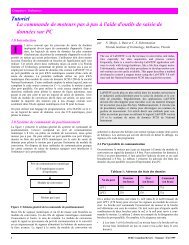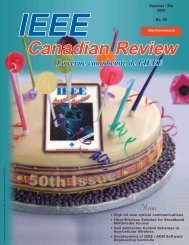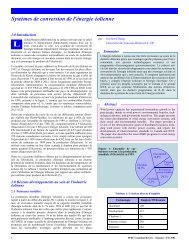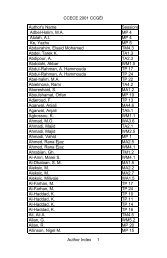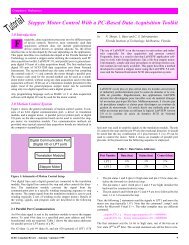Optical Fiber Components Obtained by Refraction Index ... - IEEE
Optical Fiber Components Obtained by Refraction Index ... - IEEE
Optical Fiber Components Obtained by Refraction Index ... - IEEE
Create successful ePaper yourself
Turn your PDF publications into a flip-book with our unique Google optimized e-Paper software.
of the fiber’s macroscopic structure (using CO 2 laser or an electric arc)<br />
have a high thermal stability. Moreover, these new characteristics propose<br />
new application fields like high temperature applications for electric<br />
arc induced LPFGs.<br />
The high economic potential to construct a tool that will enable us to better<br />
understand the potentials and the possibilities of this enabling technology<br />
is definitely worth investigating. This technique is not only simple<br />
to use but will provide a suitable developments on new fibre material<br />
which may radically solve the instability problem.<br />
7.0 Acknowledgement<br />
The authors would like to thank the “Faculté des Études Supérieures et<br />
de la Recherche (FESR) de l’Université de Moncton” as well as the support<br />
of all the members of EMAT (research group on Electromagnetic<br />
Application and Telecommunication).<br />
8.0 References<br />
[1] M. Akiyama, K. Nishide, K. Shima, A. Wada, R. Yanauchi, “A novel<br />
long- period fiber grating using periodically released residual stress<br />
of pure-silica core fiber,” Proc. <strong>Optical</strong> <strong>Fiber</strong> Communication Conf.,<br />
pp.276-277, 1998.<br />
[2] Y. Bouslimani, H. Hamam, O. Latry and M. Ketata, “CO 2 laser beam<br />
based technique for producing optical fiber components”, SPIE Vol.<br />
5260, p154-162, 2003.<br />
[3] T. Enomoto, M. Shigehara, S. Ishikawa, T. Danzuka, H. Kanamori,<br />
“Long-period fiber grating in a pure-silica-core fiber written <strong>by</strong><br />
residual stress relaxation”, OFC Technical Digest, pp.277-278, 1998.<br />
[4] O. Frazão, G. Rego, M. Lima, A. Teixeira, F. M. Araújo, P. André,<br />
J. F. da Rocha, H. M. Salgado “EDFA Gain Flattening Using Long-<br />
Period Fibre Gratings Based on the Electric Arc Technique”,<br />
London Communications Symposium 2001,<br />
http://www.ee.ucl.ac.uk/lcs/prog01/LCS041.pdf<br />
[5] M. Fujimaki & Y. Ohki, “Fabrication of long-period optical fiber gratings<br />
<strong>by</strong> use of ion implantation,” Optics Letters., v. 25, pp. 88-89, 2000.<br />
[6] David C. Gerstenberger, “Method and apparatus for fiber Bragg<br />
grating production,” United States Patent Application,<br />
20030048523, www.utc.fr/~farges/recherche/recherche.htm, March<br />
13, 2003.<br />
[7] Y. G. Han, W. T. Han, U. C. Paek, Y. Chung, “Tunable Bandpass<br />
Filter with novel Core Mode Blocker Fabricated <strong>by</strong> Local Heat<br />
Exposure”, Kwangju Institute of Science & Technology, 2002,<br />
http://fdlab.kjist.ac.kr/mis/publications/data/2002/256.pdf<br />
[8] G. Humbert, A. Malki, “Temperature characterization of long-period<br />
fiber gratings fabricated with electric arc discharge”, Proc. SPIE Vol.<br />
4579, pp. 176-183, 10/2001.<br />
[9] G. Humbert, A. Malki, “Characterizations at very high temperature<br />
of electric arc-induced long-period fiber,” Opt. Commun. 208,<br />
pg.329-335, 2002.<br />
[10] K.O. Hill, D.-C. Johnson, B.-S. Kawasaki: “Photosensitivity in<br />
optical fiber waveguides: application to reflection filter fabrication”<br />
in Applied Physics Letters / Vol. 32, p. 647-649 / 1978<br />
[11] I. K. Hwang, S. H. Yun, and B. Y. Kim, “Long-period fiber gratings<br />
based on periodic microbends,” Optics Letters., vol.24, pp.1263-<br />
1265, 1999.<br />
[12] G. Kakarantzas, T. E. Dimmick, T. A. Birks, R. Le Roux, P. St. J.<br />
Russell, “Miniature all-fiber devices based on CO2 laser<br />
microstructuring of tapered fibers”, Optics Letters, Vol. 26, No. 15,<br />
August 1, 2001.<br />
[13] N. Godbout, X. Daxhelet, A. Maurier, and S. Lacroix, “Long Period<br />
<strong>Fiber</strong> Grating <strong>by</strong> Electric Discharge”, ECOC’98, pg 397-398,<br />
September 1998.<br />
[14] G. Meltz, W. W. Morey, and W. H. Glenn: “Formation of Bragg<br />
gratings in optical fibers <strong>by</strong> a transverse holographic method” in<br />
Opt. letters / Vol. 14, No. 15 / 1989.<br />
[15] R. M. Mead, “Method and apparatus for fiber Bragg grating production,”<br />
United States Patent Application, 20030007730,<br />
www.utc.fr/~farges/recherche/recherche.htm, January 9, 2003.<br />
[16] N. Fisher, “<strong>Fiber</strong> Bragg grating fabrication method,” United States<br />
Patent Application, 20030002795,<br />
www.utc.fr/~farges/recherche/recherche.htm, January 2, 2003.<br />
[17] Y. J. Rao, J. D. Jones, H. Naruse, R. I. Chen, “Novel mechanical<br />
fiber optic sensors based on long-period fiber gratings written <strong>by</strong><br />
high-frequency CO2 laser pulses”, Proc. SPIE Vol. 4920, pp 43-53,<br />
9/2002.<br />
[18] G. Rego, O. Okhotnikov, E. Dianov, V. Sulimov, “High-temperature<br />
stability of long-period fiber gratings produced using an electric<br />
arc,” Journal of Lightwave Technology, pp. 1574-1579, Vol.19,<br />
Issue 10, Oct. 2001.<br />
[19] G. Rego, M. Melo, J. L. Santos, H. M. Salgado “<strong>Optical</strong> Filters for<br />
Fibre Lasers and Amplifiers”, Portugal, 2002.<br />
[20] M. Vengsarkar, P. J. Lemaire, J. B. Judkins, V. Bhatia, T. Erdogan,<br />
and J. E. Sipe, “Long-period fiber gratings as band-rejection filters,”<br />
J. Lightwave Technol., vol. 14, pp. 58–65, Jan. 1996.<br />
[21] M. L. von Bibra, A. Roberts, J. Canning, “Fabrication of long-period<br />
fiber gratings <strong>by</strong> use of focused ion-beam irradiation,” Optics<br />
Letters, Vol. 26, Issue 11, pp. 765-767, June 2001.<br />
[22] Y. P. Wang, Y. J. Rao, Z. L. Ran, T. Zhu, A. Z. Hu, “Novel tunable<br />
gain equalizer based on a long-period fiber grating written <strong>by</strong> highfrequency<br />
CO 2 laser pulses”, Proc. SPIE Vol. 4906, pp. 180-184,<br />
8/2002.<br />
[23] H. Younggeun, K. Chang-Seok, P. Un-Chul, C. Youngjoo,<br />
“Performance Enhancement of Long Period <strong>Fiber</strong> Gratings for<br />
Strain and Temperature Sensing”, IEICE Trans Electron., vol. E83-<br />
C, No.3 March 2000.<br />
About the Authors<br />
Yassine Bouslimani joined the University of Moncton in<br />
July 2000. He received an Engineering degree from<br />
University of Batna (Algeria) in 1994, a Master degree<br />
from INSA of Rouen (France) in 1995 and a Ph. D. degree<br />
from University of Rouen (France) in 1999. Between 1996<br />
and 2000 he worked as a research and teaching assistant at<br />
the department of electrical and computer engineering of<br />
the University of Rouen. His research interests include the<br />
optical fiber components and the WDM (Wavelength<br />
Division Multiplexing) technologies. He works also on the<br />
Human-Machine interaction, on the electrical devices for<br />
people with reduced mobility and on the microcontroller<br />
applications in medical and industrial fields.<br />
Jeffery Au earned his B. Eng in electrical engineering<br />
from Université de Moncton (NB, Canada) in 2002. He is<br />
currently completing his graduate studies at the same university.<br />
He is research assistant at the EMAT Laboratory<br />
(ÉlectroMagnétisme Appliqué et Télécommunications) at<br />
the same university. His areas of interest include the fiber<br />
Bragg grating (FBG), the long period fiber grating (LPFG)<br />
and the fabrication mechanics of the optical fiber components.<br />
He is a student member of the Association of<br />
Professional Engineers and Geoscientists of New<br />
Brunswick (APEGNB).<br />
Thomas Bardot is currently completing his<br />
Engineering studies at the ENIB (ECOLE<br />
NATIONALE D’INGENIEURS DE BREST),<br />
France. Between Sep. 1994 and Jan. 1995 he worked as<br />
research assistant at the at the EMAT Laboratory<br />
(ÉlectroMagnétisme Appliqué et Télécommunications)<br />
at the University of Moncton. His research interests are<br />
the fiber Bragg grating (FBG) and the long period fiber<br />
grating (LPFG).<br />
Habib Hamam obtained the B.Eng. and M.Sc. degrees in information processing<br />
from the Technical University of Munich, Germany 1988 and 1992, and the Ph.D<br />
degree in telecommunications from Université de Rennes I jointly with the France<br />
Telecom Graduate School of Brittany, France 1995. He<br />
also obtained in 2004 a postdoctoral diploma in<br />
“Habilitation of Conducting Research in Signal Processing<br />
and Telecommunications” from Université de Rennes I.<br />
He is currently an associate Professor in the Department of<br />
Electrical Engineering at the Université de Moncton, with<br />
research interests in optical telecommunications, diffraction,<br />
fiber components, optics of the eye, biomedical engineering<br />
and E-Learning. He is an associate editor of the<br />
<strong>IEEE</strong> Canadian Review.<br />
<strong>IEEE</strong> Canadian Review — Spring / Printemps 2006 13


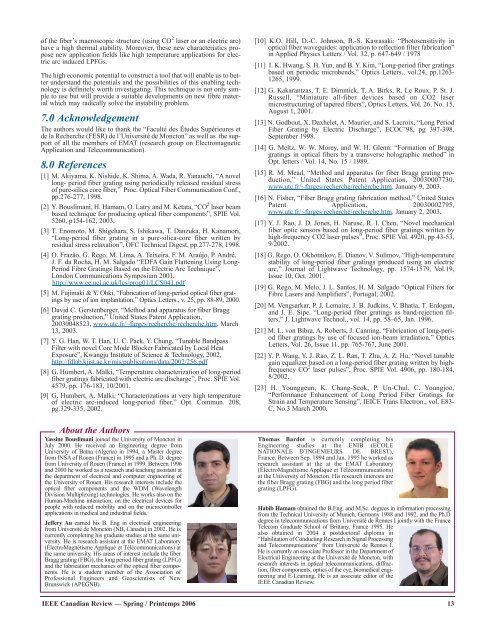
![Download Presentation [1.9MB PDF] - IEEE](https://img.yumpu.com/51364167/1/190x146/download-presentation-19mb-pdf-ieee.jpg?quality=85)

![Download Presentation [950KB PDF] - IEEE](https://img.yumpu.com/50598566/1/190x146/download-presentation-950kb-pdf-ieee.jpg?quality=85)
